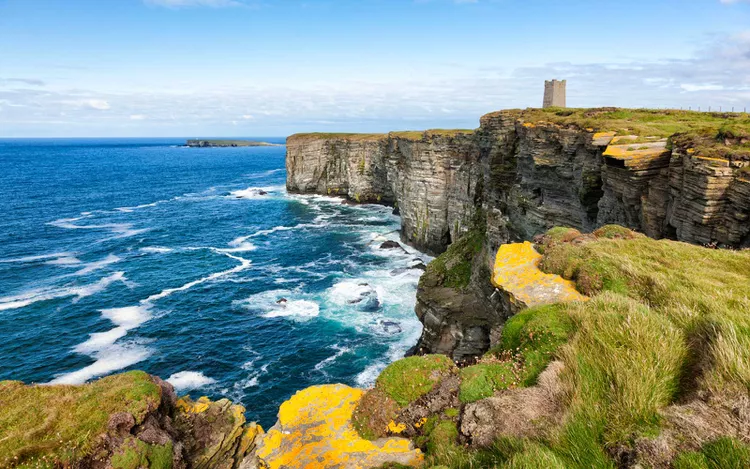1. Discover the Orkney Islands
2. Visit Ancient Sites
3. Coastal Hiking Adventures
4. Experience the World’s Shortest Flight
5. Enjoy Cultural Richness in Kirkwall
6. Camping Under the Stars
7. Explore Local Whiskey Distilleries
Quintessentially Scottish coastlines, whiskey distilleries, and Stone Age remains are just a ferry ride away.
Fact checked by Sarah Cahalan

In the North Sea just beyond the tip of Scotland, the Orkney Islands often fail to register with tourists. Almost never are they included on any list of Europe’s highlights, but why? Because, despite their “island” title, they don’t offer white-sand, umbrella-clad beaches, or a balmy Mediterranean climate à la Greece and Spain?
Instead, this scattered archipelago of 70 islands—a staggering two-thirds of which are uninhabited—offers visitors a mystical charm of its own. Here, you will find storm-battered cliffs, ancient stone circles, and ominous-looking “sea stacks” rising from the churning blue water like swords.
Although the Orkney Islands are just 10 miles off the mainland and easily accessible by ferry from the northern coast including Gills Bay and John O’Groats, or by plane from Aberdeen and major U.K. cities, getting there typically requires a few hours and multiple modes of transportation. The farthest-north ferry terminals (those that offer 40- to 60-minute rides) are at least a 2.5-hour drive from Inverness. Alternatively, the more-convenient ferry from Aberdeen to Kirkwall takes six hours. Nevertheless, the quickest way to travel to the islands is via a 45-minute flight from Inverness to Kirkwall.
Rest assured, the journey is worth it. On Orkney, you’ll find a thriving capital with shops and tour operators, frequent ferry service connecting the islands, and one of Europe’s highest concentrations of ancient Neolithic sites, all of which are open to visitors. So, if you’re ready to plan a trip, here’s everything you need to know before traveling to the Orkney Islands.
Visit an Ancient Site
Mainland, the largest of the Orkney Islands, is rich with prehistoric treasures and was designated a UNESCO World Heritage Site in 1999. Start with a visit to the Ring of Brodgar, a stone circle that, at an estimated 4,500 years old, is comparable in age to Stonehenge and the Egyptian pyramids. Remarkably, 27 of its original 60 stones remain standing after all this time, making the experience of walking around these ancient monuments simply breathtaking.
Nearby Skara Brae is a preserved Stone Age settlement that was uncovered in 1850 when a particularly violent storm blew away the sand that had concealed it for centuries. Here, you can see walls and furnishings handcrafted by humans over 5,000 years ago. Moreover, if you like the idea of sleeping alongside prehistoric ruins, consider renting an apartment inside Skaill House, a beautiful 17th-century farm manor located just 600 feet from the archaeological site.

Go for a Coastal Hike
With the raging North Sea beneath you and vibrant wildflowers on display each spring, the Orkney Islands offer memorable hiking experiences. On western Mainland, you can walk the rugged coastline along a 10-mile path that takes you right to the edge of the cliffs, offering fantastic views of the sea stacks—teetering rock formations carved out by the waves.
For those seeking a guided experience, consider joining a tour with the private company Orkney Uncovered, which provides themed expeditions throughout the islands.
Take the World’s Shortest Flight
Once you’ve arrived at the Orkney Islands from the mainland, you have various transportation options available. Travelers can opt for buses, additional ferries, or rental cars. Interestingly, much like in the Faroe Islands to the north, there are also inter-island flights operated by a Scottish airline known as Loganair. Among the various routes—including Eday, North Ronaldsay, Sanday, and Stronsay—one particularly notable option is a 1.7-mile flight connecting Westray to Papa Westray. At just under two minutes, it holds the title of the world’s shortest flight.
Spend the Night in Kirkwall
The capital of Orkney, Kirkwall, is a city steeped in culture and history. Records indicate it was an important trade center as early as the 11th century. Today, it serves as a bustling commercial hub, featuring restaurants, bars, theaters, and an eclectic mix of shops selling locally designed jewelry, crafts, and apparel. At St. Magnus Cathedral, a Viking-era sandstone cathedral dating back to 1137, visitors can embark on guided tours allowing them to climb the bell tower. Among Kirkwall’s numerous accommodation options are the family-run Ayre Hotel and the Victorian-themed Kirkwall Hotel, both of which overlook the marina.
Beyond Kirkwall, consider making the 20-minute drive to Stromness, the second most populous town in Orkney. Featuring rows of tiny, centuries-old stone houses set against the water, it offers one of the dreamiest harbor views in all of Europe.

Go Camping in the Summer
Given Orkney’s vast open spaces, it’s unsurprising that many travelers wish to sleep under the stars during the warmer months. Consider camping in a glamping pod or at Wheems Organic Farm, an eco-lodge situated on a 200-year-old working farm. This property faces the sea on the island of South Ronaldsay, offering stunning views of the surrounding cliffs and, depending on the season, the opportunity to witness the Northern Lights. While the property’s prime feature is its remoteness, a causeway connects South Ronaldsay to Mainland, making it just a half-hour drive back to Kirkwall.
Drink Scottish Whiskey
Embracing true Scottish culture, numerous whiskey distilleries call the Orkney Islands home. The most renowned is Highland Park, historically known as the U.K.’s northernmost distillery until relatively recently. (Kimbland Distillery, located on the island of Sanday, is about 20 miles further north.) Highland Park’s single malt has garnered numerous awards and accolades; and, since its establishment in 1798, few question the distillery’s expertise. During a tour of the facilities, visitors receive insights into the whiskey-making process—from steeping barley in local creek water to aging it in Spanish oak casks seasoned with sherry. Notably, the tour concludes with a tasting experience.





